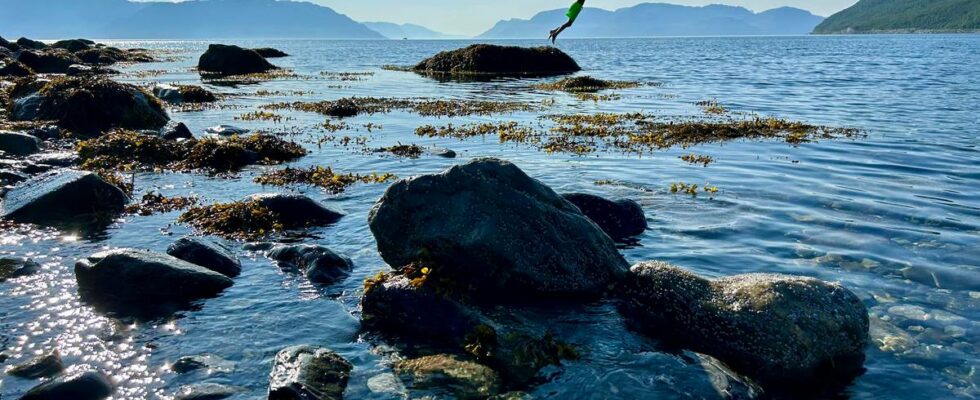– We had started to find Cherrox and a down jacket, but they are currently hanging in the hallway, laughs Ann Carolin Kvernmo. She is on the beach in Alta. Well into September, it is still over twenty degrees in the country’s northernmost county. Completely abnormal for the time of year. Autumn has so far been like summer: exceptionally warm, with an average temperature of 3.1 degrees above normal, according to the Norwegian Meteorological Institute. Ann Carolin Kvernmo ditched her trip to the mountains for a picnic on the beach with her son Håkon and her friend’s child Brage. Photo: Hanne Larsen / news My friend Maria Bjerknes thinks it’s just delicious. – I hope there will be more like that, she says. May become the norm in 10 years The hope for warm summers may very likely come true, according to climate researcher Helge Drange at the Bjerknes Center in Bergen. – What you experience as abnormal now will be more normal in 10-20 years, he says. Southern butterflies like this admiral have flocked to Finnmark in record numbers. At the same time, it has been so dry that mosquitoes have been conspicuous by their absence in many places. Photo: Knut-Sverre Horn Drange believes this year’s summer will come as a combination of natural fluctuations and global warming. And global warming is currently moving steadily in one direction. Up. – The reason is the use of coal, oil and gas, which leads to large amounts of greenhouse gas in the atmosphere, says the climate scientist. Do you think climate change is man-made? And while climate scientists worldwide calculate an average temperature increase of 1.5 degrees over the next century, this could mean a doubling in Arctic regions. According to researchers, possible reasons for this are changes in cloud cover, an increase in atmospheric water vapour, more atmospheric heat transport from lower latitudes and less sea ice. Climate researcher Helge Drange at the Bjerknes Center in Bergen believes it is important not to be so afraid that we become apathetic. Photo: Mikal Olsen Lerøen / news This will be well felt, especially in northern Norway. – This means that the annual temperature and summer temperature in the future will be at levels that we have not experienced or observed until today at all, says Drange. Worried father of two The effect of climate change is already noticeable all over the world. Also in Norway, where floods and landslides occur more and more frequently. Crops are also affected by drought worldwide, but also by extremely heavy rain. In 2022, 60,000 people died in Europe as a result of heat waves. – The situation is worrying, but we have a small window now in which we have to act. It is often the case that when we feel the climate changes on our bodies, then we are willing to do something, says Drange. Hossein Murzai is also on the beach in Alta. While family and friends enjoy Afghan dishes on the grill, the father of two admits that the good weather comes with an aftertaste. – It is actually very frightening. Because what happens when the temperature just keeps rising, he wonders. Hossein Murzai enjoys summer temperatures in September with family and friends. At the same time, he is worried. Photo: Hanne Larsen / news Drange believes there is cause for concern, but that there is still hope. However, greenhouse gas emissions must then be reduced. – We in the Western world cannot continue with the consumption we have today. Norway has a larger greenhouse gas emission per capita than the global average, Drange points out. – So it is this with fewer flights, less red meat, less online shopping, more short-travel food and more reuse that applies? – Yes, absolutely. The Low Emissions Committee 2050 has drawn up a list of 60 measures. If we follow it, it can help reduce emissions by 50-70 per cent. That has an incredible amount to say. – We need a Gerhardsen Drange recalls that we managed to reduce greenhouse gas emissions by 7 percent worldwide during the covid pandemic. So we have proven that it works. The problem is that the emissions skyrocketed after the pandemic. Drange wants brave politicians who dare to take action now, and not just talk about the future. – We need a Winston Churchill or a Gerhardsen, says the climate scientist. He believes Norway should take the lead and phase out oil and gas faster than the current plan. – We have had so much income from this, so a very good way for Norway to pay back would be to show that we can phase out in a controlled manner, says Drange. – What about municipalities, schools, sports teams, can they also do something? – Absolutely. When individuals, organizations or groups start doing something, it tends to be very contagious. Drange believes it is important that we who live in a small country do not give up and think that it is of no use. That Norway is ahead will be felt, he believes. – Start small. No individual can change the world alone, but if there are many of us who make wise choices, it helps, says Drange. Hossein Murzai tries to make environmentally friendly choices in his everyday life. Photo: Hanne Larsen / news Hossein Murzai in Alta says that he tries to do simple things in everyday life, such as sorting rubbish and using a bicycle instead of a car. – It’s small things like this that can help change the world. You have to do your best, he says. On one of the many hot September evenings in Alta, a group of students play sand volleyball outside the cathedral. Photo: Hanne Larsen / news Published 14.09.2024, at 13.08
ttn-69
Hot summers in the north may become the new normal, according to a climate researcher – news Troms and Finnmark

